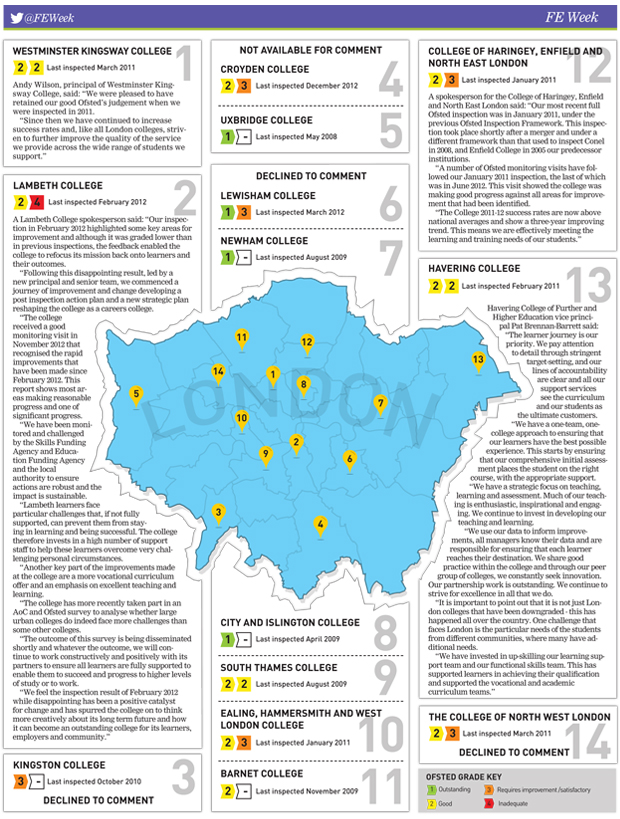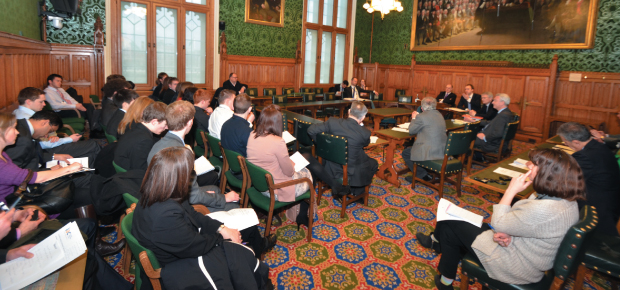Tumbling inspection grades over the last two years have begged the question ‘is London learning?’ Chris Henwood looks at what’s happening to the capital’s big colleges.
Are London colleges failing city learners? It’s a simple, but critical question based on a “worrying” trend in Ofsted judgements over the last two years.
Of the nine inspections that have taken place at the capital’s 14 biggest colleges, six have resulted in downgradings — and a couple of these were down two whole grades.
As far as these colleges inspected since 2011 go, the city has been left with an inadequate establishment, five that require improvement (or were rated as grade 3 and therefore satisfactory before September), and just three good ones.
Or, more importantly, nearly 50,000 learners are at colleges that Ofsted said were heading in the wrong direction.
The picture was so different before 2011 when, of the big colleges re-inspected since 2011, the capital boasted an outstanding college along with eight good ones – not a single grade 3, let alone any inadequate ones .
The situation, predictably, is a cause for concern.
Sean Harford, Ofsted director of the college watchdog’s newly-formed London regional office, said: “We are concerned about the performance of colleges in London. Specific issues come down to the college level, but it can’t be right that the capital has more grade 3 and 4 colleges as a proportion compared with the rest of the country. That’s what we’re concerned about at the moment.”
Just three months ago the government was urged to “shine a spotlight” on England’s FE sector with a damning annual report from Ofsted boss Sir Michael Wilshaw.
He pointed to a boom in the number of colleges branded inadequate last year — up to 13 compared to four the previous year.
But, in fairness, there do appear to be positives in the capital.
Barnet and Southgate College, for example, is rated by Ofsted as good, and in Newham College, Uxbridge College and also City and Islington College London has three outstanding establishments.
But not one of these has been inspected in the last two years.
And then again Kingston College, last inspected in October 2010, was a grade 3.
That’s not to say grades will slide further at next inspection, but there have been college grumbles over Ofsted’s new Common Inspection Framework (CIF) and the number of downgradings since it was introduced in September.
Crucially though, five of the aforementioned six downgradings took place before the new CIF.
Toni Pearce, NUS deputy president, said: “These figures start to show a concerning crash in performance from London colleges, and if that trend is mirrored nationally then ministers need to urgently investigate the reasons why.
“Ofsted has been changing their inspection framework and we know that colleges were giving their attention to areas that are no longer a priority for inspectors.
We are concerned about the performance of colleges in London”
“Regardless of whether this is a national or London only issue it is still very worrying and it’s important that Ofsted and ministers urgently investigate its cause.”
Stephen Twigg, Labour’s Shadow Education Secretary told FE Week: “There are real challenges in the quality of learning in some colleges, as highlighted by these figures.
“Principals need to address this challenge with focussed support from government. We need the same focus and rigour for colleges that Labour applied in government to improve London schools.
“Labour would work with businesses to accredit vocational courses, and raise the number of high quality apprenticeships.
“And we would give young people a clear path to progress, to a gold standard Technical Baccalaureate at age 18.”
FE Minister Matthew Hancock said: “The majority of further education colleges have a high standard of provision, with 66 per cent of colleges across the country rated as good or better.
“But we know more needs to be done, which is why we have set up the Independent Commission on Adult Vocational Teaching and Learning, are introducing the FE Guild and we are setting minimum standards that measure performance consistently across all 16-18 institutions.
“Where there are cases of a decline in performance but no swift action to improve, the Government will intervene.”
So action is needed, but is London a special case with specific problems to address?
The Association of Colleges’ (AoC) London region director, Caroline Neville, talks of having to educate “some of the most disadvantaged students in the country, as well as some of the most demographically diverse,” while Munira Mirza, London’s deputy Mayor for education and culture, mentions the city’s “difficult circumstances”.
“There is work to be done to ensure that all London colleges are the best, particularly as they deliver to some of the most disadvantaged students in the country, as well as some of the most demographically diverse,” said Ms Neville.
She added: “Ofsted’s How Colleges Improve report last year showed that funding challenges can all make improvement more difficult for a college, as can last minute changes to fee support for students and taking on a merger to support another college in difficulty.
“To support improvement, we are taking a lead in London on a good practice project in partnership with Ofsted. This will document what great teaching and learning look like in urban areas, including some of the outstanding practice that we have in colleges in the capital. This will be shared with all.”
Ms Mirza said: “A recent mayoral inquiry showed how critical high-quality education is, and the need to raise standards that equip young Londoners with the skills they need to compete on a global stage.
“Many London colleges are rated good or outstanding and they work in particularly difficult circumstances, but there is no room for complacency.
“It is good that Ofsted and others continue to challenge colleges to do better for students in London.”
She added: “We are pleased that the AoC and colleges are also working with Ofsted to make improvements across the board and will offer support through our own education and apprenticeships work as appropriate.”
So it seems the final piece of the jigsaw is to ask ‘what is being done’ about the aforementioned colleges — who qualified as the capital’s ‘biggest’ with individual total incomes for 2010/11, as declared to the Skills Funding Agency, of more than £30m.
As Ofsted’s Mr Harford pointed out: “We know there are issues, so what are we doing about it?
“We’ve got a programme of seminars and workshops aimed at getting colleges graded as satisfactory under our old framework, and requires improvement under the new one, to good.
“We’re also doing work with colleges on how to observe teaching and learning in lessons.”
He added: “Of course there are challenges for urban colleges, but a good college is a good college no matter where it is.
It is good that Ofsted and others continue to challenge colleges to do better for students in London”
“We have many, many examples of where colleges succeed in difficult circumstances so we want to spread that best practice. We’re trying to be part of the solution to improve things.”
And the Learning and Skills Improvement Service has also put forward its services. Abi Lammas, regional development manager for Greater London, said: “We offer a range of interventions to enable providers to improve. Although most of the colleges identified attained a previous grade of at least two and therefore were not eligible for the improvement and development service, they could have accessed our portfolio of other improvement services.
“However, colleges must approach improvement as something that is sustained in order to gain the desired result. Short, sharp bits and pieces of engagement in standalone — often individual — improvement do not make the necessary impact.
“Colleges that do not access holistic improvement approaches, or wait to do so until the last minute, are more likely to be downgraded at inspection.”
Click here to see the colleges’ comments. (PDF – 2mb)




